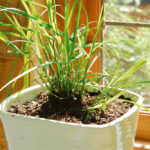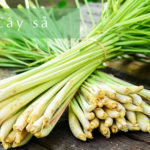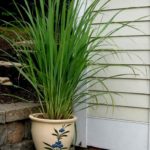Lemongrass is a popular herb used in Vietnamese cuisine, but it can be hard to find. In this guide, we’ll show you how to grow your own lemongrass in a simple container garden with just a few easy steps. With this method, you’ll be able to harvest lemongrass all year round without having to go to the market. Let’s get started!
1. What You’ll Need
- A container (such as a bucket or a small pot)
- Potting soil
- Gardening tools: hand trowel, shears, and a watering can
 Lemongrass and its necessary tools
Lemongrass and its necessary tools
Tip:
Choose healthy, robust lemongrass stalks that are still fresh and in their growth phase. Avoid picking stalks that are too young or old.
The soil doesn’t need to be fancy, it just needs to be nutrient-rich and well-drained. You can use compost, aged manure, or a mixture of regular soil and organic matter. Alternatively, you can purchase potting soil from a garden center.
2. How to Plant Lemongrass
 Steps to plant lemongrass
Steps to plant lemongrass
Note:
Plant the lemongrass at a 60-degree angle to encourage better growth. After planting, thoroughly water the soil around the base to maintain moisture.
3. Caring for Your Lemongrass
 Caring for lemongrass
Caring for lemongrass
Lemongrass is a resilient plant that can thrive in various weather conditions. However, for optimal growth, consider the following care tips:
Watering
Initially, water the lemongrass once or twice a day to promote faster growth, making sure the soil is thoroughly moistened without being waterlogged. Once the plant is established, you can reduce watering to every other day or less frequently.
Light
Place your lemongrass in a bright, sunny spot that receives morning and evening sunlight but avoid intense midday sun as it may scorch the leaves.
Fertilizer
You can purchase leaf fertilizer from a garden store or use compost or aged manure to feed your lemongrass. Fertilize once a month with a small amount.
Pests and Diseases
Lemongrass is naturally pest-resistant due to its strong scent. So, you’re unlikely to encounter any significant issues with insects or diseases.
Pruning
Remove any old, dry leaves and prune the plant if it becomes too bushy to encourage healthier growth.
How long does it take to harvest lemongrass?
 Harvesting lemongrass
Harvesting lemongrass
If you’re growing lemongrass for culinary purposes, you can start harvesting after 3-4 months. Simply cut the larger stalks and allow the smaller ones to continue growing.
For essential oil extraction, you’ll need to wait for 10-12 months until the plant is more mature and has produced a sufficient amount of oil.
To harvest, cut the leaves and sheaths about 8-10cm from the ground. Continue caring for the remaining stalks, and in 5-6 months, you’ll have a new batch of lemongrass ready for use or oil extraction. This way, you can enjoy a continuous supply of lemongrass throughout the year.
We hope this guide has inspired you to try growing your own lemongrass at home. It’s a simple and rewarding process that will add a touch of freshness to your cooking and your life!
16 Best Houseplants to Keep Mosquitoes Away
Having to deal with pesky insects such as flies and mosquitoes is something that most of us have probably experienced. Not only do these troublesome critters cause unsanitary spaces, they can also spread infectious diseases. While insecticides do the job, why not try something a little different and opt for plants to repel these insects while adding to the aesthetics of your home? Read on to learn more about the following plants that could help.



































